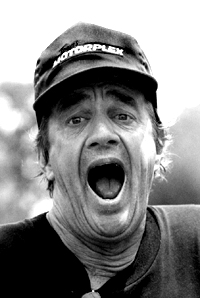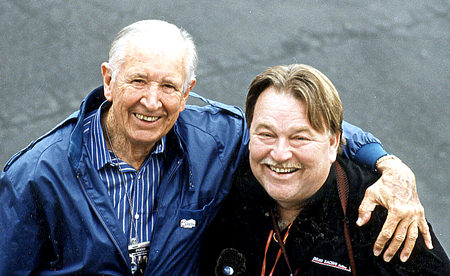 |

MERRY CHRISTMAS, WALLY PARKS
This year has been a bad one for those of us in drag racing. We
lost Mike Mitchell, Clayton Harris, Wayne Bailey, and Steve Evans, just
to mention a few. I knew some of these guys very well and considered
them my friends, but never took the time to tell them so. I just always
thought I would get the chance sometime…but now I can't. Martin and
I talked about this and decided we wouldn't let that happen again, if
we could help it. Wally Parks gave us all a scare this year and, although
it thankfully turned out to be a false alarm, it did get us thinking….
We didn't want to write an obit; we wanted to say what we felt while
the subject of the piece was still around. So, Mr. Parks, this is written
from the heart and head. What Chris has written here echoes my feelings
as well. -Jeff Burk

Photo of Wally Parks and Jeff Burk by Tim
Marshall
I've always figured that a life has been well-lived when
those who come after you are aware of your existence. People know who
you were. I'm not talking about headstone notoriety as much as I am
a public record; that you were alive on Earth and made a difference
with your little time on stage-that you carved a niche uniquely yours.
That, to me, is a successful life and certainly, at the very least,
would describe Wally Parks, past, present, and even future.
Millions leave this place every year in varying shades of anonymity.
Wally Parks is as public as city hall. For better than a half century,
people have wanted to know what Wally thought about something, what
Wally might or might not do, what Wally had said about something.
When we worked at National DRAGSTER, his wife Barbara would
tip us staffers off on the value of a story idea for the paper with
a "I don't think Wally's gonna like it" or maybe "He might like it.
You'll have to take it up with him." That was Wally's station for his
life. He was where the buck stopped; the period at the end of the sentence.
And always that punctuation shaped a subject that was cars, hot rods,
and the people who raced and lived with them.
Right now, he still casts a giant shadow and there is yet more to be
broadcast and written about Wally. His days with SCTA, his days as editor
at Hot Rod magazine, and, of course, his founding and directing the
National Hot Rod Association, his single largest contribution to the
world of sport, guarantee this. But his presence and stature registered
with me differently.
When I went to my first NHRA national event, the 1965 Winternationals,
he was just a guy who led off the pre-race parade, waving to the fans
while sitting on the back of a late model convertible. That image endures,
along with one at the end of the race where the tall slender gent, the
only one in a suit, handed out trophies. I remember thinking, "Is that
all this guy does?"
Despite that misgiving, though, there was something about the guy,
an aura if you will. You could tell that he was "the boss" and that
it extended beyond mere appearances. I found that there was genuine
content to the form here. As I got to know him and NHRA, pieces of the
puzzle began to fill in a more accurate picture of the man.
For example, when I started working at NHRA I would notice at any given
race, it could be a muggy 100 degrees outside and Wally would be on
the starting line for some presentation in a suit and tie. One dresses
up when the occasion is special and it really registered with me that
Wally treated drag racing and NHRA as things very special to him. It
meant something to him. Damn right, he'd dress up. Each and every one
of the races, the association, its paper, the racers ... all of these,
he cared about immensely. If he handed a winning racer a trophy, it
was like the Chairman of the Olympic Committee giving a winner his gold
medal. It was a special ceremony for Wally and he took serious pleasure
in it, as did the racer. Drag racing and NHRA were the biggest deals
of his life and his every waking moment reflected these passions.
Parks had to be a man of unusual insights, if for no more reason than
the manner in which I was hired at NHRA in 1975. If Wally was characterized
by a suit and tie, I was characterized at that time by a foot and a
half of hair, a Van Dyke beard, patched jeans, blue long-sleeved jail
shirts, and a runaway habit for booze and controlled substances. I will
say in my defense, though, that despite my Manson-ish appearance, I
probably knew as much about pro drag racing as anybody in the world.
Of course, that provided no iron-clad guarantees, because no one even
cared about trivia in 1975.
When I first saw Wally in his office, I was immediately taken aback.
I thought that as good as I think I am, he, in a long-sleeve shirt and
tie, might see me as a bit of an oddball, especially since I was coming
off a bender the night before, celebrating my anticipated employment
at NHRA.
To be brief (if that's not too late), Wally couldn't have really cared
less about how I looked. I had written six hard volumes of drag racing
national event/match race stats, he looked at those, smiled and told
me, "I have to admit you have a unique appearance, but you obviously
care about the sport and have an above-average knowledge of it. You've
got the job." If nothing else, and appearances aside, I knew I had found
a job with the right organization.
Organization, there's a word that continually pops into my ken when
I think of Wally Parks. To form something like NHRA, the guy at the
top would have to be meticulous in detail, capable of calling up a strong
long-range picture, know how to put the right people in the right places,
and how to deal with them. Parks excelled at all of this.
He was the perfect man for the job of forming a group like NHRA. In
1951 when NHRA was begun, drag racers were perceived as greasy street
racers and leather-jacketed hoodlums that rated only a little better
than today's contemporary gangbanger. Parks' physical bearing, his forensic
skills, and the fact that he was a gentleman in the truest sense of
the word, flew in the face of the image of hot rodding. He had to deal
with recalcitrant city councils and law enforcement, who 50 years ago
had little time for placating "hot rodders," and Parks' demeanor played
as much of a role in drag racing being established as a major sport
as did his organizational skills.
I can still see him in my mind's eye as he stood before city councils
and pleaded his case, seeking their okay for holding a drag race at
some locale. If green-lighted, he would then bend every effort at his
disposal to see that drag racing lived up to what he had said about
it, regardless of situation. The wiring up of old abandoned airports
into dragstrips in concert with supportive local politicians and law
enforcement was an act that characterized Parks' spreading of the good
word about drag racing nationally.
He and his talented sidekicks, the original NHRA Safety Safari, would
hit the interior of the country and all four corners setting up NHRA
Regional Championship Meets. By 1955, Parks and his youthful NHRA had
pulled all their forces together to the point that they were able to
host the first National Drag Racing Championships at Great Bend, Kansas.
From that point, its not hard to follow the trail to modern NHRA drag
racing, which is still the ultimate statement of the sport.
Certainly, the word spread by Parks was the gospel according to NHRA,
but what was wrong with that? It was Parks and NHRA that originally
hung their butts out and dealt with hostile forces that were eventually
won over to the sport. Still, his role in the growth of drag racing
was far less glamorous than those of headline racers, certainly in the
eyes of the fans.
Most of them would climb all over a Don Garlits for an autograph before
they would approach Parks. And not because Wally was unapproachable.
He was probably the most gracious and affable man I've ever known in
his position of leadership. In the time I've known him, I have never
heard him rip someone behind their back. No member of his staff was
ever excoriated in public. Usually, he would quietly pull you over and
ask if you had a minute that he'd like to talk. Foul language was foreign
to him. As far as I was concerned, you'd be as likely to hear Mother
Teresa call someone a motherf**ker as Wally. This decorum, coupled with
his passion for the sport, inspired tremendous loyalty and explains
why so many of the people Parks worked with in the pioneer days are
still dear friends and confidantes.
The Garlitses of the world may have popularized the sport, but it was
done on a durable bedrock created by Parks' vision and heart; his and
his NHRA cohorts. No other drag race leader or association can even
begin to compare in this vital area. Wally Parks was drag racing's Bill
France, its Abner Doubleday, its James Naismith.
Garlits is the sport's other truly great pioneer figure, and as best
as I can recall, he once said that he and Parks collided on a number
of points in their early days, but there was always a begrudging admiration
by both parties.
If I remember right, he said he came to a genuine understanding of
their relationship at one particular drag race. I'm paraphrasing Garlits
here but he said something like, "I saw Wally come up to me at this
race and he had on this coat and a badge that said "Official," and I
looked at it and thought to myself, 'By golly, that's it. I wanted to
be a racer and he wanted to be an official and I guess that's what separated
us.'"
Like poet Robert Frost's road coming to a fork in the woods, Parks
chose one path and it made all the difference in the world. His SCTA,
Bonneville, and Muroc racing and attendant organizational experiences
cleaned his windshield and cleared his vision and at some point, he
caught a glimpse of the future. And I'll be damned if it didn't include
all of us.
Thanks and Merry Christmas, Wally and Barbara.
photo of Chris
Martin by Jeff Burk
|
 |
|